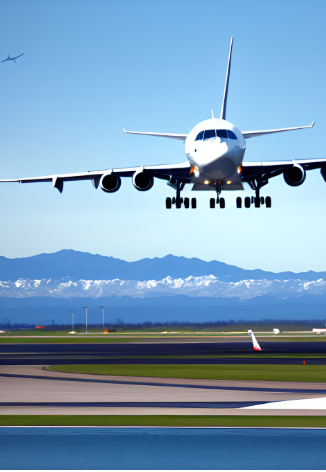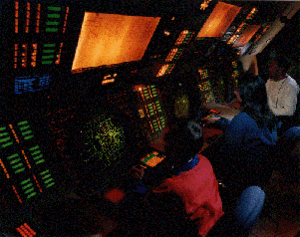- Air Homepage
- Weather Radar
- Air Traffic Radar
A look at what air traffic radar can do
Air traffic radar helps ground control teams direct aircraft, both in the air and on the ground. Radar creates a real-time map of the airspace, so controllers can monitor traffic, adjust routes, and alert pilots of potential collisions. Aircraft, passengers, and ground crew are all safer this way.
Find more about aviation here.
Radar's Unseen Watchman: How it keeps planes safe 📡What if an invisible electronic eye tracked every plane in the sky, making split-second calculations to keep you safe? Find out how radio signals and transponders work together to guide planes through three dimensions and maintain order in the world's most complex airspace.
Info about this radar technology might appeal to to you. Aviation enthusiasts, frequent travelers, and tech geeks will love its insights into radar's crucial role in safety and efficiency.
Safe and Efficient Air Traffic Control with Radar
Safety and national security fans will also enjoy it. Moreover, students studying aviation or related fields benefit from its detailed explanations and real-world applications.
Nevertheless, even the general public with a curiosity about technology will appreciate this summary, as it is supposed to cater to a wide range of readers interested in air traffic control radar systems.
Here's a bit more: Air traffic control radar might be interesting to the public for several reasons:
- Air traffic control radar helps air traffic controllers track aircraft and guide them to their destinations safely, ensuring the safety of air travel. A lot of people, especially those who travel by air, want to know if the air traffic control system works.
- Air traffic control radar also manages air traffic flow, which can cause delays and impact flight schedules. Travelers, especially those who travel frequently for work or pleasure, may be interested in how air traffic control radar minimizes flight delays.
- Air traffic control radar can also detect unauthorized or suspicious aircraft that could threaten national security. Understanding how air traffic control radar protects the country's safety and security might be interesting to the public.
- Radar is a complex technology that involves advanced engineering, software, and data processing. You just might find air traffic control radar fascinating and informative.
Radar information helps air traffic controllers keep aircraft apart. If two aircraft are too close, the controller will tell one to change altitude or direction to keep them apart.
How do they know? They use mathematical formulas to do it. The calculations make aircraft separation possible in three dimensions: laterally, longitudinally, and vertically.
Radar helps you make split-second decisions. Controllers use the system to figure out what instructions to send. Pilots and crew can be notified about dangerous air traffic situations and hazardous weather systems.
Computers send a lot of air-to-ground info these days. Air traffic controllers and pilots communicate better, so there are fewer errors.
What happens with the air traffic radar data
Electronic screens Electronic screens show radar and flight info. Data can also be relayed faster this way.
Keeping track of planes and watching the weather requires primary and secondary radar displays. Secondary air traffic radars are usually attached to the same pole as primary radars and work together synchronously.
Radar information helps prepare clearance information for aircraft. Both instrument and visual flight rules (IFR and VFR) airplanes get advisories and instructions from controllers. Radar traffic advisories may list altitudes, ranges, and bearings of aircraft near other flight paths based on radar information.
By knowing and using this data, aircraft can maintain separation from other craft within their air space to prevent collisions.
How the information gets around
A high frequency signal burst from the primary radar sends out an echo from every aircraft. It works like a weather radar. By knowing where each aircraft is, the controller can track its path. Transponder-equipped planes can also respond to the beacon.
A special device queries the aircraft and gets vital info. A stream of data known as the Mode C signal pulse gets the plane's altitude.
It gets its identity from Mode A. Transponders can automatically reply to Mode C queries. A pilot must manually enter four numbers to answer a Mode A query. By using radar, air traffic controllers can calculate ground speed, assess the current air traffic situation, and track each plane's magnetic heading.
Radars display electronic maps and calculated flight plans for every plane. A plane's altitude, speed, direction, and location can be calculated using radio signals. Other types of radar show ships, cars, and storms the same way.
The radar transmitter sends out short, high frequency radio pulse waves that bounce off the target. A fraction of a second later, the transmitter closes while the receiver opens to receive the echo.
Radar measures the time it took for signals to get back to the receiver. Radar equipment calculates echoed signals' Doppler shift. Analyzing these measurements gives you the aircraft's location and speed.
The radar antenna sends radio waves to the aircraft and picks up the weaker returns. As radio waves are easy signals to amplify, even weak radio waves can be processed with the use of amplification.
Go back from Air Traffic Radar to the Radar Real Time Weather web page.
You may be interested in air traffic control radar for a variety of reasons, from safety concerns to technological curiosity.
Search this site for more information now.
What is on your screen when it comes to air traffic radar?
What role does radar play in the aviation traffic control system?
Find out what else this radar does.
Do you have concerns about air pollution in your area??
Perhaps modelling air pollution will provide the answers to your question.
That is what I do on a full-time basis. Find out if it is necessary for your project.
Have your Say...
on the StuffintheAir facebook page
Other topics listed in these guides:
The Stuff-in-the-Air Site Map
And,
Thank you to my research and writing assistants, ChatGPT and WordTune, as well as Wombo and others for the images.
OpenAI's large-scale language generation model (and others provided by Google and Meta), helped generate this text. As soon as draft language is generated, the author reviews, edits, and revises it to their own liking and is responsible for the content.



New! Comments
Do you like what you see here? Please let us know in the box below.